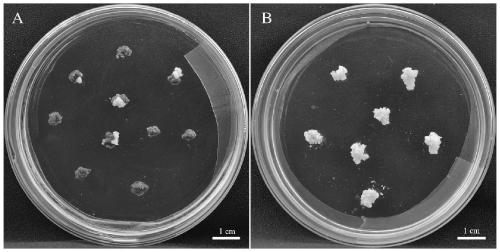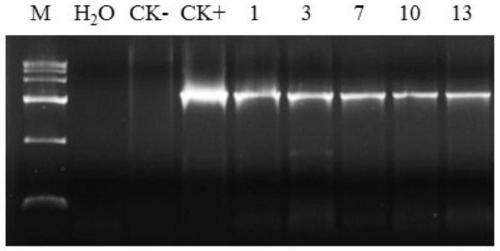Key gene LhHB9 for somatic embryo radicle elongation of liriodendron hybrids and application thereof
A technology of Liriodendron body and key genes, which is applied to the key gene LhHB9 of hybrid Liriodendron radicle elongation and its application field, can solve the problems of inconsistent development, small number, small individuals, etc., and achieve good practicability Effect
- Summary
- Abstract
- Description
- Claims
- Application Information
AI Technical Summary
Problems solved by technology
Method used
Image
Examples
Embodiment 1
[0019] Embodiment 1 LhHB9 gene cloning
[0020] 1. Extraction of hybrid tulip tree RNA
[0021] The leaves of Liriodendron tulipifera were used as materials to extract RNA. The specific steps are: (1) Use liquid nitrogen to fully pre-cool the mortar until the liquid nitrogen is added to the mortar until it no longer boils; (2) Put no more than 50mg of plant tissue into Fully grind in a mortar filled with liquid nitrogen (2-3 times); (3) When the liquid nitrogen is partially volatilized and the sample is not melted, add 1mL of lysate, continue to grind until the sample is completely mixed with the lyse, and place at room temperature (4) Use a pipette gun to transfer the homogenate to a 2mL centrifuge tube; (5) Centrifuge at 12000r / min for 2 minutes at room temperature, absorb the upper layer liquid and transfer it to a new tube; (6) Add an equal volume of 24:1, vortex and mix well, centrifuge at 12000r / min for 2 minutes, absorb the uppermost liquid and transfer to a new tube, ...
Embodiment 2
[0041] Embodiment 2 LhHB9 gene functional verification
[0042] 1. Construction of LhHB9 overexpression vector
[0043] The basic vector used in the construction of the target gene and target gene mutant transient expression vector is PJIT166. The vector was constructed using the method of homologous recombination. The reagent used was Gibson of NEB Master mix, the entire assembly process can be found on the NEB website https: / / www.neb.com / applications / cloning-and-synthetic-biology / dna-assembly-and-cloning / g ibson-assembly.
[0044] (1) PCR to generate insert fragments
[0045] Use the NEBuilder online website (http: / / nebuilder.neb.com / ) to design primers, and the primer sequences are as follows:
[0046] PJIT166-LhHB9F: 5′-ggagaggacagcccaagcttATGGCGCTTGCGATGCAC-3′,
[0047] PJIT166-LhHB9R: 5'-gctcaccatggatcctctagaAAGAAAAGACCAGTTCATGAACAAGAAGGC-3'.
[0048] Target gene and T-Vector pMD TM 19 (Simple) The positive plasmid with correct sequencing was used as a template, ...
PUM
 Login to View More
Login to View More Abstract
Description
Claims
Application Information
 Login to View More
Login to View More - R&D
- Intellectual Property
- Life Sciences
- Materials
- Tech Scout
- Unparalleled Data Quality
- Higher Quality Content
- 60% Fewer Hallucinations
Browse by: Latest US Patents, China's latest patents, Technical Efficacy Thesaurus, Application Domain, Technology Topic, Popular Technical Reports.
© 2025 PatSnap. All rights reserved.Legal|Privacy policy|Modern Slavery Act Transparency Statement|Sitemap|About US| Contact US: help@patsnap.com



